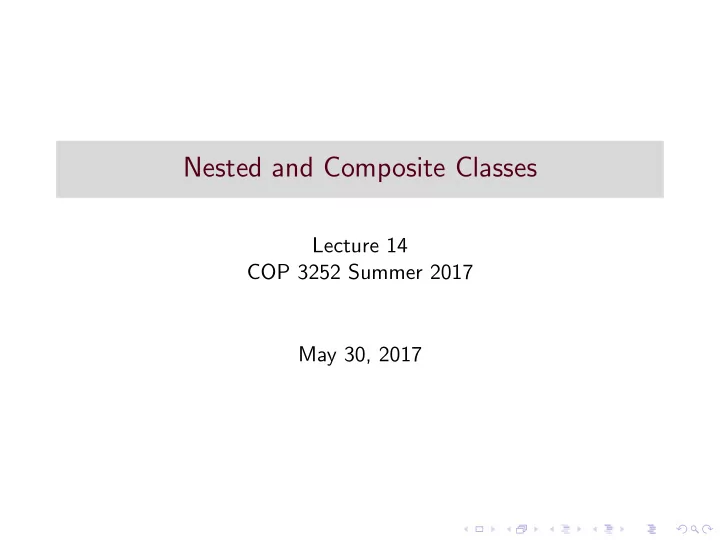

Nested and Composite Classes Lecture 14 COP 3252 Summer 2017 May 30, 2017
Nested Classes ◮ The Java programming language allows you to define a class within another class. Such a class is called a nested class. ◮ Nested classes are divided into two categories: static and non-static. ◮ Nested classes that are declared static are called static nested classes. Non-static nested classes are called inner classes. class OuterClass { ... static class StaticNestedClass { ... } class InnerClass { ... } }
Access ◮ A nested class is a member of its enclosing class. ◮ Non-static nested classes (inner classes) have access to other members of the enclosing class, even if they are declared private. ◮ Static nested classes do not have access to other members of the enclosing class. ◮ As a member of the OuterClass, a nested class can be declared private, public, protected, or package private. (Outer classes can only be declared public or package private.) ◮ Why Use Nested Classes? ◮ It is a way of logically grouping classes that are only used in one place ◮ It increases encapsulation ◮ It can lead to more readable and maintainable code
Static Nested Classes ◮ A static nested class is behaviorally a top-level class that has been nested in another top-level class for packaging convenience. ◮ A static nested class is associated with its outer class. cannot refer directly to instance variables or methods defined in its enclosing class: it can use them only through an object reference ◮ Static nested classes are accessed using the enclosing class name: OuterClass.StaticNestedClass ◮ For example, to create an object for the static nested class, use this syntax: OuterClass.StaticNestedClass nestedObject = new OuterClass.StaticNestedClass();
Inner Classes ◮ An inner class is associated with an instance of its enclosing class and has direct access to that object’s methods and fields. ◮ Also, because an inner class is associated with an instance, it cannot define any static members itself. ◮ To instantiate an inner class, you must first instantiate the outer class. Then, create the inner object within the outer object with this syntax: OuterClass.InnerClass innerObject = outerObject.new InnerClass();
Composition of Classes ◮ Composition is preferred over inheritance when there is a ”has-a” relationship between the two classes. ◮ Java composition is achieved by using instance variables that refers to other objects. ◮ Using composition, one can control the visibility of other object to client classes and reuse only what’s needed.
Recommend
More recommend